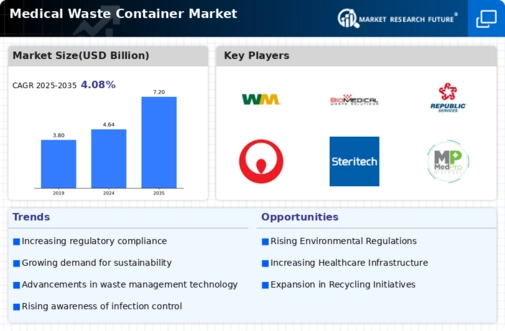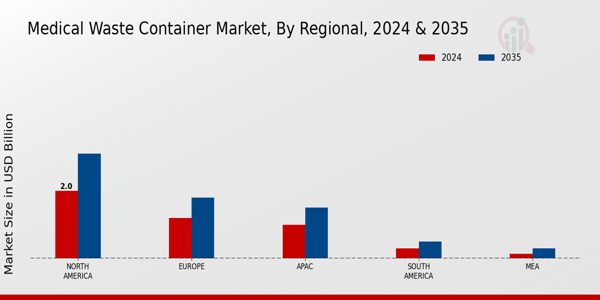Increasing Healthcare Expenditure
The rising healthcare expenditure across various regions appears to be a pivotal driver for the Medical Waste Container Market. As healthcare facilities expand and upgrade their services, the demand for efficient waste management solutions intensifies. In recent years, healthcare spending has surged, with estimates indicating that it could reach trillions of dollars by 2025. This increase necessitates the implementation of effective waste disposal systems, including medical waste containers, to ensure compliance with safety regulations. Consequently, healthcare providers are likely to invest in advanced medical waste containers that meet stringent standards, thereby propelling market growth.
Growing Awareness of Infection Control
The heightened awareness surrounding infection control and prevention is likely to significantly influence the Medical Waste Container Market. Healthcare facilities are increasingly recognizing the importance of proper waste segregation and disposal to mitigate the risk of healthcare-associated infections. This awareness has led to the adoption of specialized medical waste containers designed to safely contain hazardous materials. Market data suggests that the demand for such containers is expected to rise, as healthcare providers prioritize patient safety and regulatory compliance. The emphasis on infection control measures is thus a critical driver for the market.
Rising Number of Healthcare Facilities
The increasing number of healthcare facilities, including hospitals, clinics, and laboratories, is a significant driver for the Medical Waste Container Market. As new healthcare establishments emerge, the need for effective waste management solutions becomes more pronounced. Data indicates that the number of healthcare facilities is on an upward trajectory, which correlates with a growing demand for medical waste containers. This trend suggests that as more facilities open, the market for medical waste containers will expand, necessitating the development of tailored solutions to meet diverse waste disposal needs.
Regulatory Pressure for Safe Waste Disposal
Regulatory pressure for safe waste disposal practices is a crucial factor influencing the Medical Waste Container Market. Governments and health organizations worldwide are implementing stringent regulations to ensure the safe handling and disposal of medical waste. Compliance with these regulations is essential for healthcare providers, driving the demand for reliable medical waste containers. The market is likely to see growth as facilities invest in compliant waste management solutions to avoid penalties and ensure public safety. This regulatory landscape is expected to continue shaping the market dynamics in the foreseeable future.
Advancements in Waste Management Technologies
Technological advancements in waste management are poised to reshape the Medical Waste Container Market. Innovations such as smart containers equipped with sensors for monitoring waste levels and tracking disposal processes are emerging. These technologies not only enhance operational efficiency but also ensure compliance with environmental regulations. The integration of such advanced solutions is expected to attract investments from healthcare facilities seeking to optimize their waste management practices. As a result, the market for medical waste containers is likely to experience substantial growth, driven by the demand for innovative waste management technologies.


















Leave a Comment